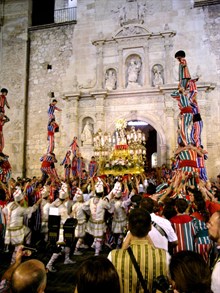The feast of the Virgen de la Salud of Algemesí (Valencia)
The feast of the Virgen de la Salud (Mare de Deu de la Salut in Valencian) is famous in Algemesí, a town in the province of Valencia, on 7 and 8 September each year. The ceremony takes place in the historic quarters of the city (Valencia, Muntanya, Santa Bárbara and La Capella). In 2011 it was declared a UNESCO Intangible Cultural Heritage of Humanity. Legend has it that an image of the Virgin was found in the thirteenth century. The current image, which is paraded during the two days of celebration surrounded by traditional dancers, was created after the Civil War (1936-1939). The Feast of Algemesí is an extraordinary collective staging, made up of theater performances, concerts and dances, involving nearly 1,500 actors.
 During the procession that takes place on the first day of the feast, biblical episodes are evoked and some of the most famous martyrdoms of Christendom (Santa Barbara and San Bernardo), a performance that brings to mind the medieval mystery plays. This procession, called las Promesas, also includes the presence of a cross and the banner of the Virgin, both in Baroque style. On this occasion, you can also see traditional dances, including the spectacular Muixeranga: a dance that culminates in the formation of huge human pyramids, known in Catalan as castels (castles), formed by actors who take each other on shoulders to reach dizzying heights (photo).
During the procession that takes place on the first day of the feast, biblical episodes are evoked and some of the most famous martyrdoms of Christendom (Santa Barbara and San Bernardo), a performance that brings to mind the medieval mystery plays. This procession, called las Promesas, also includes the presence of a cross and the banner of the Virgin, both in Baroque style. On this occasion, you can also see traditional dances, including the spectacular Muixeranga: a dance that culminates in the formation of huge human pyramids, known in Catalan as castels (castles), formed by actors who take each other on shoulders to reach dizzying heights (photo).
On the eighth of September the morning procession is held. This event was attended by giant puppets who impersonate King Jaume I of Aragon and his wife Yolanda of HungaryYolanda or Violant of Hungary (1215-1251) was the daughter of King Andrew II of Hungary and the Princess of Constantinople Yolanda de Courtenay. In 1235 she married King Jaume I of Aragon (1208-1276), thus becoming queen consort of his vast possessions: the kingdoms of Aragon, Valencia and Mallorca, the county of Barcelona, the lordship of Montpellier and other fiefs in Occitania. Among the couple’s children, were Peter III the Great (1239-1285), the King of Aragon and Valencia, and Jaume II of Majorca (1243-1311) King of Majorca and Lord of Occitan, land he inherited from his father.: two enormous statues which are also found in the Feast of Nuestra Señora de las mercedes, Our Lady of Mercy, in Barcelona. The morning procession is the most spectacular moment of the feast of Algemesí: waiting for the pageant of Our Lady to pass through the church door, a cloud of dancers performs in the courtyard of the basilica of Saint James. The evening, however, begins with the last parade, called the Volta Gran in Valencian. In this parade, which lasts for seven hours on the streets of the old town, numerous characters of the Old and New Testament take part, accompanied by the patrons of the Valencian Community.
